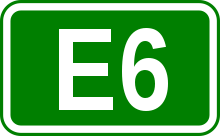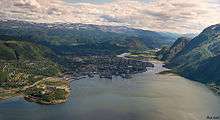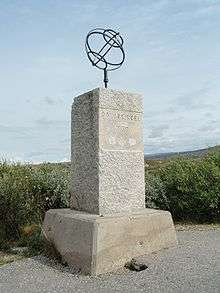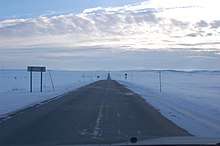E6 through Sweden and Norway
European route E6 stretches from Trelleborg in Sweden to Kirkenes in Norway, 3120 km in total. The leg through Norway is 2628 km and the longest road within a single country in Europe except Russia. Much of the E6 is scenic, especially in Northern Norway where it provides an astounding view of the mountains and fjords. E6 crosses the Arctic circle at Saltfjellet mountain pass and more than 1000 km of the road is within the area of the midnight sun. During summer months there is almost 24 hour daylight along most of the route (while in winter daylight hours are correspondingly limited).
- This article is an itinerary.
.svg.png)

Understand
The E6 is Norway's main road in the south-north direction and in some areas of the northern Norway it is in fact the only road. E6 is a key reference for a self-drive trip in Norway and the road is simply referred to as "the E6" (Eseksen).
There is one ferry crossing remaining, the 8 km stretch across Tysfjord, and about 80 tunnels. The entire route is 3,140 km (1,950 miles) or 40-50 hours driving. That means five-six days driving is needed at normal pace, visitors doing sightseeing and frequent stops should calculate more time. The route is constructed as motorway (multi-lane controlled-access highway) until Hamar, about 210 km of 2600 km within Norway (speed limit 90 to 110 km/h). In addition there is some 200 km semi-motorway (two-lane expressway) with speed limit 80 or 90 km/h.
While the E6 in Sweden and around Oslo runs through lowlands and flatlands, further north, the route includes mountain passes above the tree limit:
- Dovrefjell between Dombås and Oppdal, 1026 meters above sea level
- Saltfjellet between Mo-i-Rana and Fauske, 693 meters
- Kvænangsfjellet, North Troms, 402 meters
Mountain passes and some exposed sections in Northern Norway are occasionally closed in extreme winter conditions, primarily at night. Convoy driving is also used during blizzards, drivers then have to wait for the snowplow. Driving in winter conditions in the north is recommended only for experienced winter drivers. Even if elevations are modest, mountain passes like Kvænangsfjellet is exposed to rough weather. E6 partly runs through the coldest areas in Norway with Karasjok's -51.4°C (-61°F) the coldest ever recorded in Norway. The interior of Northern Norway is however relatively warm in summer, although in places like Karasjok there can be real frost also then. While large parts of E6 is north of the Arctic circle, the climate is generally not arctic because the coast enjoys the mild Gulf stream in the Atlantic. During winter the interior can be 10 or 20°C colder than port towns like Trondheim or Narvik.
| Town | July average | January average | Coldest ever | Warmest ever |
|---|---|---|---|---|
| Gothenburg | 18.9 | +0.1 | -26.0 | 33.8 |
| Oslo | 16.4 | -4.3 | -26.0 | 35.0 |
| Lillehammer | 14.8 | -9.1 | 34.0 | |
| Trondheim | 14.4 | -2.3 | -25.0 | 35.0 |
| Narvik | 13.4 | -4.1 | -20 | 32.5 |
| Karasjok | 13.4 | -17.1 | -51.4 | 32.4 |
Between Karasjok and Tana bridge, the E6 runs for 180 km along the big Tana river and the border with Finland.
Distances
| To-From | Kilometers | Time needed | Notes |
|---|---|---|---|
| Oslo-North cape (Nordkapp) | 2200 | 35 hours net ≈ 1 week incl sleeping |
Ferry |
| Oslo-Bodø | 1200 | 20 hours net 3 days incl sleeping | |
| Bodø-Nordkapp | 1050 | 16 hours (2 days) | Ferry |
History
The stretch through Nordland county is about 650 km and is the most complex part of the E6. In 1941 the road through Nordland, Troms and Finnmark was made passable but had 10 ferry crossings. New stretches were built by the Nazi regime during the war. Captured foreign soldiers were exploited as slave laborers. The stretch of road between Rognan and Langset was named The Blood Road because of this.
Get in
.jpg)

Ferries from Germany (Rostock, Travemünde/Lübeck or Sassnitz) or Poland (Świnoujście) to Trelleborg in Sweden. It is possible to skip the Swedish part of E6 entirely though. There is a ferry line from Kiel in Germany to Oslo in Norway.
From Denmark the Öresund Bridge from Copenhagen to Malmö or the ferry from Helsingør to Helsingborg. There are also ferries connecting the Danish peninsula Jutland with Sweden. Either from Grenå to Varberg, from Frederikshavn to Gothenburg or even directly to Oslo in Norway.
Though a south-to-north passage might be natural for visitors from mainland Europe, a north-to-south passage gives a better view of the scenery. There are several ways to start from the northern end. Getting to the far end of the E6, driving as little as possible, can be done by taking the ferry from Travemünde, Germany to Helsinki, Finland, and then have you and your vehicle transported by VR car-carrier train from Helsinki to either Kolari or Rovaniemi, north of respectively at the Arctic circle. All that remains is a 6–7 hours drive to Kirkenes (about 500 km). Alternatively, a drive up through Finland from Helsinki is some 1,300 km.
A scenic route through Sweden is the E45, also called Inlandsvägen (The Inland Road), which begins as an offramp to the E6 in central Gothenburg. The E45 goes through some of the least inhabited areas is Sweden, so make sure your vehicle is reliable. The E4 through Sweden is limited-access expressway (motorway) until Norrland, but you have to get through Stockholm with it's heavy traffic.
If you're arriving from Russia, there's also a road from Murmansk. The border between Norway and Russia is a Schengen outer border.
The E6 connects to European route E18 (east-west road) at Oslo, E39 at Trondheim, E12 at Mo i Rana, E8 at Skibotn (near Tromsø) and E75 in Tana.
Go
Sweden
All of the E6 through Sweden consists of limited-access expressway (motorway). The route is not very scenic, and mostly used for convenience. Since Trelleborg is a major port for trucks to and from the continent, the E6 has heavy traffic during working hours between Trelleborg and Helsingborg.
On the leg between Malmö and Gothenburg, the train is usually a faster option.
Drivers who have time and want to enjoy a waterfront view, can find parallel routes closer to the sea.
- 🌍 Trelleborg. Sweden's southernmost city.
- 🌍 Malmö. Sweden's third city.
- 🌍 Helsingborg. Junctions with E4 through Sweden
- Halmstad, Sweden's golf capital.
- Falkenberg
- Varberg
- Kungsbacka
- 🌍 Gothenburg. Sweden's second city and largest port. Junction with E45.
- Uddevalla
- Strömstad, a border city, and the last chance to buy supplies before Norway.
Norway


E6 from the border to Hamar is limited access expressway (motorway), this stretch is only partly scenic. From Hamar to Ringebu the E6 is a semi-motorway. There are tolls on many sections of the E6, mostly from the Swedish border up to Trondheim.
- 🌍 Halden. - first town in Norway.
- Sarpsborg
- Moss
- 🌍 Oslo. Norway's capital and largest city.
- 🌍 Oslo Airport, Gardermoen. Main airport for East Norway close to E6.
- 🌍 Lillehammer. A ski resort which hosted the 1994 Winter Olympics.
- 🌍 Gudbrandsdalen. Norway's great central valley
- Dombås, village northern part of Gudbrandsdalen, junction with E136, railway junction, ski slopes.
- 🌍
Dovrefjell.

- 🌍 Oppdal. A major ski resort in the upland valleys.
- 🌍 . A small art museum by the road. It is open 24/7 and you can park outside, in the road on the right hand side, as you go northward.
- 🌍 Trondheim. the capital of Trøndelag. Connection to European route E39.
- Stjørdal with Trondheim airport, the nearby village Hell might be interesting for English-speaking travellers, road and rail from Sweden.
- 🌍 Mosjøen. A fine little town at the mouth of Vefsn river
- 🌍 Mo i Rana. Second largest town in Nordland county.
- 🌍
Saltfjellet mountain pass.

- 🌍 Fauske. With Bodø nearby.
- 🌍 Narvik. A port city connected by rail to Sweden. Junction with E10. From here you can take a detour to the Lofoten archipelago.
- Nordkjosbotn junction, 80 km to Tromsø, main city of the north
- 🌍 Lyngen. The magnificent Lyngen Alps and fjords.
- 🌍 Alta. The main town of Finnmark, roads into the Finnmark plateau.
- Detour to Nordkapp
- 🌍 Karasjok. This village in Finnmark's interior is the Sami capital and often the town with Norway's coldest winter temperatures.
- Tana bru - bridge across Tana river
- 🌍 Kirkenes. End of the route, 15 km from Russia
Detours
The coastal road 160 in Sweden offers beautiful sea views.
At Ringebu in Gudbrandsdalen valley along the mountain road through Rondane back onto E6 Dovrefjell.
Steinkjer-Bodø along county road 17 is known as Helgeland coast road (also known as Kystriksveien) and is also designated as a national tourist route. The 630 km route is much slower than the E6, also includes six ferry crossings. Towns and destinations along the Helgeland coast road: Namsos, Brønnøysund, Tonnes, and Vega archipelago, an UNESCO World Heritage Site.
Hurtigruten following the Norwegian coast will go fairly near the E6 approximately starting from Trondheim and all the way to Kirkenes. Most ships can transport cars too, so this can be an interesting break from all the driving — and the scenes are at least as beautiful.
Shortcuts
- Between Oslo and Trondheim, road 3 is 25 km shorter, and around 20 min faster, but less scenic mountain views.
- Between Ringebu and Dovrefjell, road 27 over Folldal is slightly shorter with a very scenic view of Rondane.

- From the south to Finnmark county, going through Sweden and Finland is much shorter and faster.
By bicycle

E6 south of Lillehammer is motorway and not suitable or permitted for bicycles. Through Gudbrandsdalen until Otta traffic is often heavy and cycling not recommended or not permitted on semi-motorways. There are however parallel local roads that can be used by bicycle such that E6 can also be used to plan a bicycle trip. Parallel alternative roads are usually at the opposite side of the river. Between Nord-Sel and Dovre through Rosten gorge there is no parallel road. E6 between Dombås and Oppdal does not have a parallel road suitable for cycling, traffic is fast so cycling can be unpleasant even if legal.
Significant construction work on E6 through Gudbrandsdalen (Ringebu-Sjoa) was completed in 2016 and the new road longer runs through Kvam, Vinstra and Hundorp villages. Construction continues north of Sjoa. Between Otta and Trondheim there are a few, short tunnels. There is also motorway around Trondheim and Trondheim airport at Stjørdal. In Nordland county there are many and some very long tunnels. There is a "National cycle route 1" or "EuroVelo 1" which follows routes 720 and 17 Trondheim-Bodø and then the ferry to Lofoten. Bicyclists should avoid tunnels, but if using them, use a reflective vest which petrol stations sell. In some tunnels cycling is explicitly forbidden.
Hitchhiking
The E6 is Norway's main road and usually the best choice for fast road transport. There is generally traffic any time of day (except in the very north) and traffic is often long distance. South of Hamar and around Trondheim the E6 is a motorway and hitchhiking is possible only from petrol stations, other stops and connecting roads. From Hamar to Ringebu the E6 is a semi-motorway not open to pedestrians and bicycles. Further north hitchhiking is usually legal on the E6 but drivers may be reluctant to stop because of dense traffic and high speed. General advice for hitchhikers is to wait at places where cars drive slowly, such as gas stations.
Stay safe

Driving in Norway and Sweden is generally safe as these countries maintain the highest road safety in the world.
The E6 runs through some of the coldest and roughest climates in Europe. The high plateaus are exposed to strong wind in the winter. In the interior areas such as Gudbrandsdalen and Finnmark temperatures can drop to -30 or -40°C, creating problems for cars, particularly those with diesel engines; see Winter driving.
The period from mid-June to mid-August should provide the least challenges for drivers, since the midnight sun allows for driving around the clock north of the Arctic circle. In this period it is possible to read a newspaper outdoors in the middle of the night, just by the means of sunlight. The last snow normally melts around Midsummer in the valleys and on the plateaus, which makes it much safer to drive. Keep in mind that the sun, when the weather allows, will shine much brighter than at sea level. Bring sunglasses and suntan lotion.
![]()
